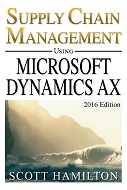Fundamentals of Transportation in Microsoft Dynamics AX
Editor's Note: This article is drawn from Scott's recent book about Warehouse Management using Microsoft Dynamics AX: 2016 Edition.
 The various options for
transportation management within Microsoft Dynamics AX share several fundamental
concepts about sales orders, transfer orders and purchase orders. Examples
include the expected transportation times, the significance of delivery dates used
in master scheduling logic, and the charges associated with freight. These basic
considerations apply to both major options for warehouse management (consisting
of basic and advanced WMS), both currently available software versions (consisting
of AX 2012 R3 and the new Dynamics AX), and to the options for advanced
transportation management.
The various options for
transportation management within Microsoft Dynamics AX share several fundamental
concepts about sales orders, transfer orders and purchase orders. Examples
include the expected transportation times, the significance of delivery dates used
in master scheduling logic, and the charges associated with freight. These basic
considerations apply to both major options for warehouse management (consisting
of basic and advanced WMS), both currently available software versions (consisting
of AX 2012 R3 and the new Dynamics AX), and to the options for advanced
transportation management.
This article summarizes the fundamentals of transportation for supply chain management of different types of orders. It provides illustrative case studies, and consists of the following sections:
- Transportation Basics for Sales Orders
- Transportation Basics for Transfer Orders
- Transportation Basics for Purchase Orders
These fundamentals reflect key aspects of how a company models and manages its supply chain, where required dates (such as shipment and delivery dates) provide the basis for coordination. The additional aspects of any transportation management capabilities need to support these detailed game plans or update the details if they change - such as changing a ship date or a delivery date.
1. Transportation Basics for Sales Orders
FREE Membership Required to View Full Content:
Joining MSDynamicsWorld.com gives you free, unlimited access to news, analysis, white papers, case studies, product brochures, and more. You can also receive periodic email newsletters with the latest relevant articles and content updates.
Learn more about us here





